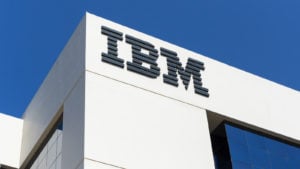Seasoned investors realize dividend investing is a time-tested strategy that might be appropriate for most buy-and-hold retail portfolios. They are not interested in timing highly volatile momentum. Instead their investment strategy is, at least in part, to buy shares in high quality dividend-paying companies and then reinvest those dividends over a long period of time, such as until retirement years. Then they begin collecting this passive income stream. Today’s article, therefore, introduces seven of the best tech dividend stocks.
When companies are profitable, they make a decision as to whether to distribute the profits as dividends or keep as retained earnings. Management usually never wants to decrease or axe the dividend. Such a cut would potentially signal financial stress, reducing confidence in the firms. Most investors regard dividend distribution as a positive signal regarding future income (or cash flows).
Shares of dividend-paying businesses tend to keep their most of their value even in market declines. Investors, especially those who rely on that passive income, often never sell their shares. After all, regardless of any short-term volatility in the stock market that might affect share prices, the dividend is a definite return on investment.
In investing, the aim is achieving an acceptable total return that is consistent with an investor’s objectives. Tech stocks are mostly regarded as growth shares. In other words, individuals may not necessarily associate them with dividends. However, there are a number of tech darlings of Wall Street that also pay dividends. They tend to be more mature technology businesses with predictable revenues and cash flows. Thus they might be offering investors the best of both worlds with potential share price growth as well as passive income.
Recent research led by Greg Filbeck of the Black School of Business at Penn State Behrend in Erie, PA highlights, “Dividend-yield strategies generate investor interest because they have historically offered better risk-adjusted performance.” Put another way, the case for investing in dividend-paying companies remains strong, and over time, buy-and-hold investors are likely to be well rewarded.
Most investors like to include technology shares in their portfolios. With that information, here are seven tech dividend stocks for long-term portfolios:
- AT&T (NYSE:T)
- Broadcom (NASDAQ:AVGO)
- Corning (NYSE:GLW)
- Defiance Next Gen Connectivity ETF (NYSEARCA:FIVG)
- International Business Machines (NYSE:IBM)
- Texas Instruments (NASDAQ:TXN)
- Vanguard Information Technology Index Fund ETF Shares (NYSEARCA:VGT)
Dividend Stocks: AT&T (T)

52-Week Range: $26.08 – $34.61
1-Year Price Change: Down about 15%
Dividend Yield: 6.94%
Our first stock for today might appeal to contrarian and value investors. Over the past year, the Street has regarded Texas-based AT&T with significant pessimism. The group operates in telecommunications, media and technology. Its segments include AT&T Communications, WarnerMedia and AT&T Latin America.
In late January, the company announced fourth-quarter financial results. Revenue was $45.7 billion, a decline of 2.3% year-over-year (YoY). Adjusted earnings-per-share for the quarter was 75 cents, down 15.7% YoY. However, free cash flow stood at $7.7 billion, a figure that pleased analysts.
CEO John Stankey said, “We ended the year with strong momentum in our market focus areas of broadband connectivity and software-based entertainment. […] And the release of Wonder Woman 1984 helped drive our domestic HBO Max and HBO subscribers to more than 41 million, a full two years faster than our initial forecast.”
Forward price-to-earnings (P/E) and price-to-sales (P/S) ratios are 9.35 and 1.24, respectively. The Street blames the high debt levels for the recent poor performance of T shares. However, others believe it is manageable. At current prices, I find the valuation level enticing. With a dividend yield of over 7%, AT&T deserves your interest.
Broadcom (AVGO)
52-week range: $155.67 – $495.14
1-year price change: Up about 94%
Dividend yield: 3.17%
Chip group Broadcom has been a tech darling for many years. It offers semiconductor infrastructure software solutions. In 2020, AVGO stocks reported solid gains, and the median target of analysts’ price estimates currently stands at $500.
Broadcom released Q1 2021 financials in early March. The top line grew by 14% YoY to $6.6 billion. Non-GAAP net earnings came at $2.97 billion in Q1 2021. A year ago, they had been $2.37 billion. Diluted EPS inched up $1.36 to hit $6.61 in Q1 2021. Free cash flow was shy of $3 billion. For Q2 2021, management’s revenue guidance is approximately $6.5 billion.
“This quarter highlights the strength of our financial model with 14% year over year revenue growth translating to an increase in operating profit of 23%,” said CFO Kirsten Spears. “We continue to deliver strong free cash flow, approximately $3 billion in the quarter, representing 35% growth on a year on year basis.”
AVGO stock’s forward P/E and P/S ratios are 16.86 and 7.94, respectively. In the past decade, management grew the top line both by making several impressive acquisitions as well as by achieving organic growth. The coming years are likely to see further shareholder growth.
Corning (GLW)

52-week range: $17.44 – 40.24
1-year price change: Up about 75%
Dividend yield: 2.4%
Electronics component manufacturer Corning is our next dividend stock. It produces specialty glass, ceramics and technologies for the telecommunications and electronics industry. Its fiber optic equipment is used in electronics, life sciences and the automotive industries. For instance, we find Corning’s electronics components in mobile phones, automobiles, data centers, and scientific test kits and products.
In recent months, Corning has been getting significant attention due to its 5G prospects. It supplies indoor networks that are 5G ready. The group also provides glass and ceramic shields for Apple’s iPhone 12. Therefore, Corning will benefit from increased iPhone sales and 5G rollout. Going forward, analysts expect 5G to increase revenue in the optical communications segment.
In late January, it released robust Q4 and full-year metrics. Core sales of $3.3 billion was up 11% sequentially and 17% YoY. Core EPS came at 52 cents, up 21% sequentially and 13% YoY. Free cash flow was $464 million. Investors were pleased with strong metrics across all segments.
Chief Financial Officer Tony Tripeny cited, “We expect year-over-year growth to accelerate in the first quarter of 2021. We expect core sales of $3.0 billion to $3.2 billion – compared with $2.5 billion in the first quarter last year – and EPS of $0.40 to $0.44, which is double last year’s first-quarter EPS at the low end of the range. ”
GLW stock’s forward P/E and P/S ratios stand at 19.08 and 2.56. A potential decline toward the $35 level would improve the margin of safety. With a market capitalization (cap) of almost $30 billion, Corning is likely to register further growth.
Defiance Next Gen Connectivity ETF (FIVG)

52-week range: $18.66 – $37.09
1-year price change: Up about 51%
Dividend yield: 1%
Expense ratio: 0.3%, or $30 per $10,000 invested annually
Our next choice is an exchange-traded fund (ETF), namely the Defiance Next Gen Connectivity fund. The fund focuses on the 5G revolution that is upon us. The “fifth generation” technology is the most recent standard for cellular networks. It provides exposure to businesses that are behind the growth of 5G technologies. Leading chip names, cloud businesses, telecoms and satellite-based communications groups are among the companies represented.
The fund started trading in March 2019 and net assets stand at $1.1 billion. FIVG, which has 77 holdings, tracks the returns of the BlueStar Global 5G Communications Index. The components of the index are reviewed semi-annually. NXP Semiconductors (NASDAQ:NXPI), Analog Devices (NASDAQ:ADI), LM Ericsson Telefon (NASDAQ:ERIC), Qualcomm (NASDAQ:QCOM), and Keysight Technologies (NYSE:KEYS) are among the top names in the roster.
In the past 12 months, the fund has had a spectacular return and hit a record high in February. But so far in 2021, FIVG has only returned about 1%. Before long, a large number of gadgets used in personal and professional lives will rely on 5G technology. This ETF could be appropriate for many retail investors as it offers diversification across many stocks.
International Business Machines (IBM)

52-week range: $90.56 – $135.88
1-year price change: Up about 18%
Dividend yield: 5.1%
Armonk, New York-headquartered tech giant International Business Machines has a long history as a dividend stock. However, over the past decade, amidst the global technological transformation, IBM has seen revenues shrink. In other words, the company has been playing catch up.
The iconic industrial giant offers software, information technology (IT) services and hardware. 97% of the world’s largest banks are IBM’s clients. Its mainframes handle 90% of all credit card transactions globally. Management is working hard to make the group a dominant fintech and blockchain player.
The company reported Q4 and full year results on Jan. 21. Quarterly net revenue was $20.4 billion, a decline of 6% YoY. Yet, analysts were pleased to see that total cloud revenue came at $7.5 billion, up 10% YoY. The company has been focusing on increased cloud-based software solutions.
Non-GAAP net income and diluted EPS were $1.9 billion and $2.07, respectively, both down 56% YoY. IBM’s free cash flow was $6.1 billion during the quarter.
“We made progress in 2020 growing our hybrid cloud platform as the foundation for our clients’ digital transformations while dealing with the broader uncertainty of the macro environment.” said Arvind Krishna, IBM CEO. “The actions we are taking to focus on hybrid cloud and AI will take hold, giving us confidence we can achieve revenue growth in 2021.”
IBM stock’s forward P/E and P/S ratios stand at 11.52 and 1.55. Management’s objective is to make IBM a leaner operation with cloud based recurring revenue streams. Since its acquisition of Red Hat, IBM’s focus has moved to artificial intelligence (AI) and cloud operations. If you believe its shares are likely to shine again, then now might be a good time to buy this dividend stock.
Texas Instruments (TXN)

52-week range: $93.09 – $181.80
1-year price change: Up about 65%
Dividend yield: 2.33%
Diversified semiconductor bellwether Texas Instruments designs, manufactures, and sells analog and embedded processing chips. The end markets include industrial, automotive, personal electronics, communications equipment and enterprise systems. It has 14 manufacturing sites worldwide.
In late January, Texas Instruments announced Q4 metrics. Revenue was $4.08 billion, an increase of 22% YoY. Net income came at $1.69 billion, up 58% YoY. Similarly EPS of $1.80 meant an increase of 61% YoY. Finally, free cash flow in Q4 was $1.9 billion.
CEO Rich Templeton commented, “Together, our dividends and stock repurchases reflect our continued commitment to return all free cash flow to our owners. TI’s first quarter outlook is for revenue in the range of $3.79 billion to $4.11 billion and earnings per share between $1.44 and $1.66.”
We have to note that 90% of sales are from outside the U.S. As a result of the recent weakness in the value of the greenback, Texas Instruments will likely to see higher revenues in the coming quarters.
TXN stock’s forward P/E and P/S ratios are 25.58 and 10.84, respectively. In the past year, investors have priced in a V-shaped recovery in semiconductor demand, especially in cars and industrials. And TI shares have returned over 60%. Therefore, potential short-term profit-taking is likely. And decline toward the $160 level would improve the margin of safety.
Vanguard Information Technology Index Fund ETF Shares (VGT)

52-week range: $179.45 – $382.73
1-year price change: Up about 64%
Dividend yield:0.82%
Expense ratio: 0.1%
Our final discussion centers around another tech ETF. The Vanguard Information Technology ETF gives access to diversified tech businesses. The fund started trading in January 2004, and net assets stand close to $47 billion.
VGT, which tracks the returns of the MSCI US IMI Info Technology 25/50 index, holds 345 companies. Over 57% of the assets are in the top 10 names. Thus, substantial price moves in these names affect the value of the fund. In terms of sectors, technology hardware, storage and peripheral leads with 23.2%. Next in line are systems software (20.1%), semiconductors (15.9%), and application software (13.3%).
Apple (NASDAQ:AAPL), Microsoft (NASDAQ:MSFT), Nvidia (NASDAQ:NVDA), Visa (NYSE:V), Mastercard (NYSE:MA), and PayPal (NASDAQ:PYPL) are among top the names in the roster. In recent years, these firms have been tech darlings and growth leaders.
Given the recent up in the share price of many of these companies, there could soon be profit-taking in the fund. However, the new decade is likely to be shaped by technological innovations. Therefore, the fund deserves to be on your radar.
On the date of publication, Tezcan Gecgil is long T stock.
Tezcan Gecgil has worked in investment management for over two decades in the U.S. and U.K. In addition to formal higher education in the field, she has also completed all 3 levels of the Chartered Market Technician (CMT) examination. Her passion is for options trading based on technical analysis of fundamentally strong companies. She especially enjoys setting up weekly covered calls for income generation.
